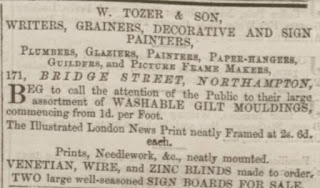Still I will do my best to paint a picture of William's short life and the time in which he lived.
William Frederick Tozer was born on the 1st May 1840 at 70 Hatfield Street, Christ Church Surrey, the second child to William Henry Tozer and Maria Bishop. On his birth certificate his father is recorded as being a painter.
William wasn't baptised until the 27th August 1841 and on this register his birth date is given as 16th July 1840. In 1851 they were living in the St.Pancras area of London and his father was a Journeyman Painter, also William Frederick had several more younger brothers and sisters.
By the time of the 1861 census his father had set up his own Painting and Decorating company in Northampton employing 1 man and 3 apprentices, both William and his elder brother Charles were working for their father and in a newspaper advertisement of 1862 you can read that their work wasn't just painting and decorating but also involved picture framing, guilding, plumbing and sign writing (that must be were my daughter Esther got her talent for sign writing from).
Shortly after this date William Frederick found work as a Grainer and Painter in Royal Tunbridge Wells, Kent, and it was whilst living here that he probably met his future wife Eliza Lowman Challis, daughter of Henry Challis of Ramsgate, Kent.
William and Eliza were married in the St. Mary The Virgin church in Dover on the 4th June 1866, he was 26 years old and Eliza was 24.
In December 1867 their first child was born in Royal Tunbridge Wells, he was named William Henry Tozer after his grandfather.
Shortly after the birth of their son, William Frederick and Eliza moved back to Northamptonshire where William started his own painting and decorating company, located at 34 Market Street, Wellingborough. In 1870 his second son Frederick was born and on the 9th October 1871, Eliza gave birth to my great grandmother Rose Tozer.
William Frederick's business seems to have been very successful, in fact he was asked to help in the decoration of the large hall of the newly built Corn Exchange of Wellingborough. According to the local newspaper his finished work reflected his good ability as a decorative painter.
Unfortunately William Frederick's promising career came to an end with his untimely death on the 15th May 1872, caused by an ear infection which spread to his brain, he was only 32 years old and his wife Eliza was left with three young children.
I will post a copy of his testament in my next blog.




























